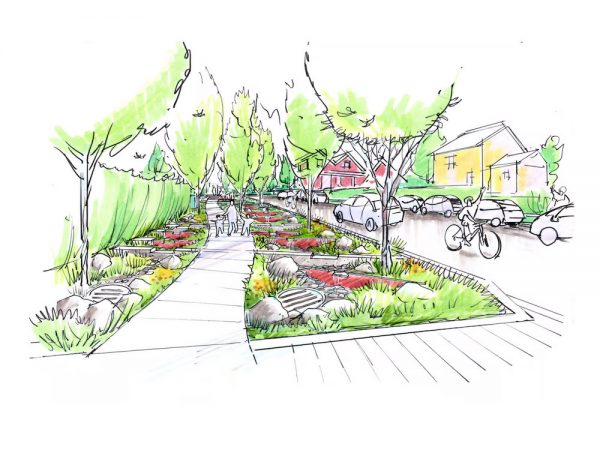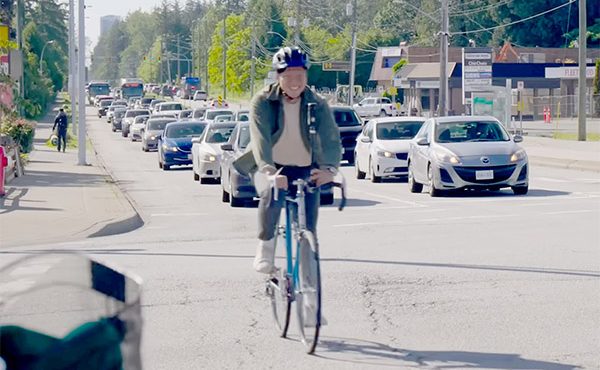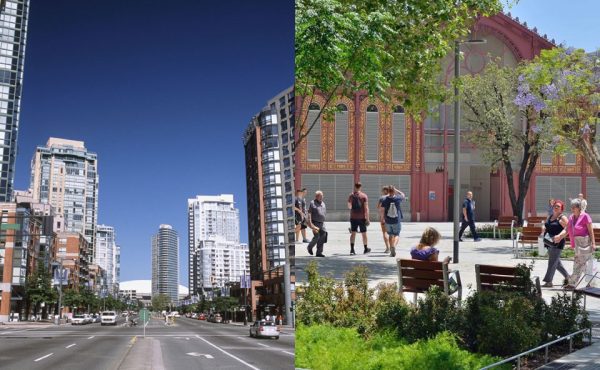
They buried the creek under St. George Street to make room for roads and houses.
Little waterways like it, fed by rainwater, were once everywhere in Vancouver, flowing down the slopes into False Creek, English Bay, Burrard Inlet and the Fraser River. Over 50 of them spawned salmon.
Over a century ago, as the city developed, all but a few of these creeks and streams have been piped and culverted, hidden underground.
But if you’re at the intersection of St. George and Sixth Avenue in the neighbourhood of Mount Pleasant, walk over to the manhole. You can hear it better in the winter, but even in the summer, the sound is unmistakable: running water.
“You might not see it,” said Rita Wong, a nearby resident, “but it’s still there.”
Wong has been listening to the rush of that lost creek for almost two decades. Together with her neighbours, they’ve been trying to bring it back.
Back in 2004, a master’s thesis on the potential of daylighting the creek was written by Bryn Davidson, the local architect who has gone on to be known as a designer of laneway housing.
Over the years, Wong, neighbours and local streamkeepers carried that conversation forward, involving artists and local elementary schools to champion the creek’s return with tours, presentations and a colourful mural stretching down St. George Street for passersby to imagine the water’s path.
Their efforts caught the attention of city staff, but it would take years before any money was committed to the creek.
“Trying to navigate any kind of bureaucracy in government, it takes time,” said Wong. “You have to figure out who’s inside that bureaucracy who understands the value of what you’re trying to do.”
Wong and the others knew what they didn’t want: a plaque in remembrance of the lost creek.
“How could we have something that’s actually functional? That has an environmental logic and purpose?”
In 2013, the City of Vancouver committed to exploring opportunities for daylighting creeks and streams in Mount Pleasant, including St. George Street, as part of its community plan.
Then in 2016, the city council approved a rainwater management plan, mandated by the province, which evolved into Vancouver’s Rain City Strategy.
Among the aims: restoring urban watersheds and treating the abundant rainwater as a resource in the city that is often dubbed “Raincouver.”
In 2019, the money finally came. The city provided funding to the St. George project as part of its capital plan, expected to cost between $5 and $6 million. Public engagement for the long-awaited project finally kicked off, involving groups as young as elementary school-aged Brownies and Cub Scouts.
The city, however, found that daylighting the creek would not be possible, as sewers and gas lines were in the way.
Instead, a path following the historic creek would be created for rainwater to travel — a “rainway.”
From floods to flows
Urbanized cities like Vancouver are paved with hard surfaces, which are not climate-resistant.
Hard surfaces cause urban flooding if there is extreme rainfall. A lack of green spaces creates hot pockets called “heat islands” in the face of weather events like 2021’s fatal heat dome.
Hard surfaces, which make up 55 percent of Vancouver’s surface area, also mean that the city has a difficult time collecting and cleaning rainwater. This is why green infrastructure that can perform the function of natural ecosystems is needed.
“We have a ton of pollutants that come into our rainwater, mostly off of roads,” said Julie McManus, project manager with the City of Vancouver’s green infrastructure branch.
That rainwater runoff picks up everything from hydrocarbons and petroleum, heavy metals from tires and rooftops, chemicals from fertilizers, bacteria from animal waste and microplastics from aging vehicles and buildings.
“A lot of the time, that is just flushed directly into the Fraser River or the ocean,” said McManus.
To reintroduce natural solutions, Vancouver has experimented with a number of green rainwater infrastructure projects that other rainy West Coast cities like Seattle and Portland have adopted too, from permeable pavement, tree trenches, and rain gardens to vegetated channels called swales. Vancouver is also gradually daylighting a small number of waterways like Still Creek.
But a grand, multi-block neighbourhood project like the St. George rainway will be the “first of its kind,” said McManus, with the first stretch of the rainway spanning Broadway downhill to Fifth Avenue.
Instead of curbs, much of this stretch has gravel for street-side parking, which is frequently washed away by the rain, an echo of the creek.
“You can definitely see how much erosion and damage is done by the rain, and the velocity at which it comes down St. George Street,” said McManus. “It goes to show that we build to try and hide [waterways], but nature takes its course.”
Plants play a key role in filtering polluted runoffs. The city has had great success with juncus effusus, a member of the rush family, as part of its green infrastructure. A hardy “superstar,” the grass is native to B.C., evergreen and creates habitat too.
Participants during the city’s public engagements also voted for the planting of beardtongue, western columbine, wood sorrel and tiger lily, all of which are native pollinator plants that will attract birds and bees.
The city is also adding bioengineered soils to help filter out pollutants. New street trees will help keep the rainway cool.
Like the city’s other green rainwater infrastructure projects, the rainway will be able to store the volume of water from extreme storms, 48 millimetres of rainwater every 24 hours, cleaning it before it infiltrates into the ground.
“The core of what we’re trying to do through the Rain City Strategy is set things back as best as we can to their natural state,” said McManus.
As a result, the natural quality of the rainway will require less maintenance than a typical manicured garden.
To make the rainway more enjoyable and interactive, the idea for a path alongside the rainway, accessible to people of all ages and abilities, came out of public engagement.
There was also a desire to reduce vehicle traffic and street parking. Naturally, there was some opposition to this, but participants overwhelmingly voted in favour of more space for the rainway and less for cars.
“There’s always going to be people who care more about parking than ecological well-being,” said Wong. “But there’s enough people who understand why it’s important and are willing to change their behaviour and make small adjustments in their lifestyle to co-exist with biological regeneration.”
Changing the course?
Construction on the rainway began earlier this year and is expected to be completed by the end of 2024.
After that, two more potential phases could see the rainway extended to Kingsway, the headwaters of the historic St. George Creek.
The city hopes that the project can serve as an educational reminder about hydrology in “Raincouver” and the need for green rain infrastructure.
McManus credits the St. George group for years of advocacy to get the St. George rainway, the city’s first, underway. There are already residents in other neighbourhoods asking the city about rainways of their own.
A little over half of Vancouver’s area is made up of hard surfaces. The city is aiming to manage 40 percent of the water that falls on those surfaces by 2050 with green rainwater infrastructure.
“For a lot of people, underground infrastructure is really hard to understand,” said McManus. “You really need that history part to have that message hit home… to let them see how much has changed, how much has been buried and how that is impacting our quality of life.”
Rita Wong knows what that’s like, having grown up in Calgary on Treaty 7 territory without knowing that the drinking water came from the Bow and Elbow Rivers.
Wong these days wears many hats as a poet, an activist and an associate professor of critical and cultural studies at the Emily Carr University of Art and Design. Water is a big part of all of her work.
“You go and see these places, like up in the Peace Valley that is being destroyed, it really is anguishing and painful to the soul,” she said. “To finally have something good happening, even at this small scale, is so important.”
It might not be an expansive river, but Wong believes this neighbourhood-scale project has a lot to teach urban dwellers about the importance of water in the face of climate change and polluting megaprojects elsewhere in the province.
“My hope is that when something like this happens in the city, that logic and that knowledge helps to shift the larger systems that we’re in. It is possible to change our mistakes. That’s a lot of joy in doing that, taking some responsibility and helping things move in a better direction.”
…
Christopher Cheung is a reporter at The Tyee, where this story originally appeared.




